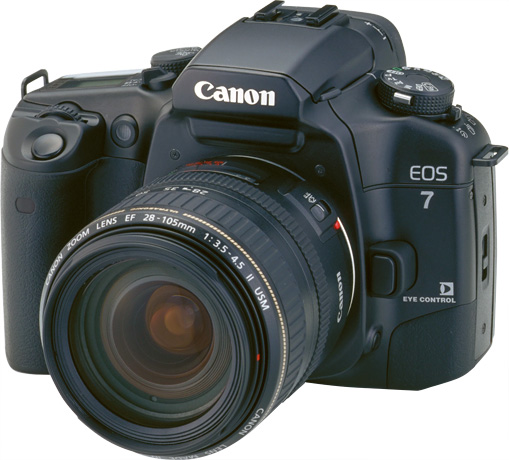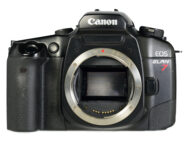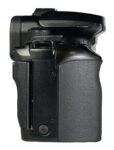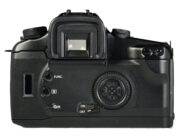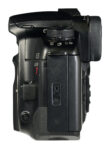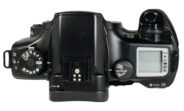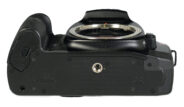Announced
Production status
System
Canon EOS system cameras
- Canon EF-M
- Canon EOS 10 S
- Canon EOS 10D
- Canon EOS 1D
- Canon EOS 1D mark II
- Canon EOS 1D mark II N
- Canon EOS 1D mark III
- Canon EOS 1D mark IV
- Canon EOS 1D X
- Canon EOS 1D X Mark II
- Canon EOS 1D X Mark III
- Canon EOS 1Ds
- Canon EOS 1Ds mark II
- Canon EOS 1Ds mark III
- Canon EOS 3
- Canon EOS 3000
- Canon EOS 5000
- Canon EOS 5D
- Canon EOS 5D mark II
- Canon EOS 5D mark III
- Canon EOS 5D mark IV
- Canon EOS 5Ds
- Canon EOS 5Ds R
- Canon EOS 620
- Canon EOS 630
- Canon EOS 650
- Canon EOS 6D
- Canon EOS 6D Mark II
- Canon EOS 700
- Canon EOS 750 QD
- Canon EOS 850
- Canon EOS A2
- Canon EOS D30
- Canon EOS D60
- Canon EOS ELAN
- Canon EOS ELAN 7E
- Canon EOS ELAN 7NE
- Canon EOS ELAN II
- Canon EOS IX
- Canon EOS IX Lite
- Canon EOS Rebel 2000
- Canon EOS Rebel G
- Canon EOS Rebel K2
- Canon EOS Rebel S II QD
- Canon EOS Rebel T2
- Canon EOS Rebel Ti
- Canon EOS Rebel X
- Canon EOS Rebel XS
- Canon EOS Rebel XS N DATE
- Canon EOS RT
- Canon EOS-1
- Canon EOS-1N
- Canon EOS-1N RS
- Canon EOS-1V
Canon EOS ELAN 7E
aka Canon EOS 30
aka Canon EOS 33
aka Canon EOS 7
aka Canon EOS ELAN 7
35mm AF film SLR camera • Discontinued
Specification
| Format: | |
| 35mm full frame | |
Film type: | 135 cartridge-loaded film |
| Canon EF [44mm] | |
| Shutter: | |
Type: | Focal-plane |
Model: | Electronically controlled |
Speeds: | 30 - 1/4000 + B |
| Exposure: | |
Exposure metering: | Through-the-lens (TTL), open-aperture |
Exposure modes: | Programmed Auto |
| Aperture-priority Auto | |
| Shutter-priority Auto | |
| Manual | |
| Physical characteristics: | |
Weight: | 580g |
Dimensions: | 146.7x103x69mm |
Manufacturer description #1
August 24, 2000
CANON INTRODUCES THE EOS 30 WITH SOPHISTICATED CAMERA TECHNOLOGY
Canon has introduced the high performance EOS 30 35mm AF SLR camera with a host of features incorporated into a compactly designed neat body.
The EOS 30 features a high precision focusing system using a CMOS sensor, 7-point AF and the fastest ever Eye-Control system with SI focusing point display. Such technology combined with other enhanced features and of course compatibility with the extensive range of over 50 EF lenses and accessories make the EOS 30 the perfect choice for advanced amateurs.
The EOS 30 design is compact and sturdy, with easily accessible controls for quick and easy execution of camera's operations.
On the top of the camera are three dials serving as the user interface. This includes new focusing point selection keys within the Quick Control Dial, allowing for quick and easy selection of the seven focusing points.
There is a separate Eye Control switch which when used gives the fastest eye detection response in the EOS range.
Canon has refined its eye-controlled focus system first seen on the EOS 5, making it faster and more precise. Eye Control focus can be used with the camera held vertically as well as horizontally.
By combining the area AF and eye-control, focus is achieved at the point selected by the users eye.
The Eye Control mode uses a new algorithm for automatic focusing point selection. Eye Control information is taken into account by this and the selection priority for each focusing point thereby changes accordingly, allowing the user to select the focusing point desired.
In addition to Eye Control selection, the focusing point can be selected automatically by the camera, or set manually allowing the user to set the controls for point-and-shoot photography, exercise control over some of the features or use the manual mode.
Outstanding high speed focus tracking is achieved using a 32bit micro-computer and high speed predictive algorithm. When used with Canon's EF 300mm f/2.8L IS USM lens the camera can track a moving subject approaching at a speed of 50kph up to as close as 8 meters, this is as fast as Canon's top-of-the-range EOS 1V and EOS 3.
The fastest AF SLR in its class with four frames per second (fps) shooting with AF and Ai Servo AF is possible with the new battery pack BP300. Using the built-in motordrive, 3.5fps can be achieved with extremely low noise level.
The EOS 30 uses Canon's evaluative metering, with seven metering methods compatible with the area AF System. Readings are taken from 35 different areas of the scene. The built-in computer then compares these readings to a library of typical scenes. In this way, the camera is able to detect light or dark backgrounds or other difficult subjects, and adjust the exposure accordingly.
For occasions when evaluative metering is not appropriate, partial metering can be used. This takes a reading from 10% of the viewfinder area (the important area of the subject) and ignores the background. Readings can be taken from the centre of the frame, or linked to the active focusing point. Centre-weighted exposure metering reads from the entire image area, but is influenced most by the central subject area. The shutter speed range of the EOS 30 is 30 sec to 1/4000 sec and its maximum sync speed is 1/125 sec.
The EOS 30 offers a range of shooting modes for every subject. There are ten in total, with one of these settings offering a further choice of 5 programs including the addition of a Night Scene mode.
- Intelligent Program AE
- Shutter Speed Priority AE
- Aperture Priority AE
- Depth-of-Field AE
- Full Auto
- Program Image Control (Portrait, Landscape, Close-up, Sports and Night Scene)
- E-TTL Program Flash
- TTL Program Flash AE (for compatibility with EZ-series Speedlites)
- A-TTL program flash AE
- Metered manual exposure
The camera has a retractable built-in flash, which uses 3-zone TTL auto flash metering linked to the focusing points. In Full Auto or Programmed Image Control modes, the built-in flash pops up and fires automatically in low-light or backlit conditions.
The EOS 30 features 13 custom functions allowing the user to configure some of the camera settings to your own requirements.
Remote control operation is possible with the RC-1 for wireless picture-taking or the RS-60E3 for wired picture-taking. The film advance feature with a new self-timer setting can also be used with remote control operation.
New Accessories
To compliment the EOS 30, a range of new accessories have been launched
A new shoe-mounted Speedlite 420EX has an auto zoom head and E-TTL auto flash metering. It has attractive new features such as an AF-assist light linked to 7 focusing points, horizontal bounce flash and a wireless slave unit setting.
The new BP300 battery pack with vertical grip shutter button, uses AA size (Ni-Cd or Nickel hydride). The vertical grip features a shutter button and AE/FE lock button.
Other new accessories include a wide strap EW-100BK and semi-hard case EH14-L.
The EOS 30 is available from October at an RRP of £449.99 (body only)
Manufacturer description #2
19th April 2001
Canon Adds The EOS 33 To It's SLR Line-Up
Canon has added the high performance EOS 33, 35mm AF SLR camera to its award winning SLR range. The EOS 33 offers a host of Canon features in a compact and sturdy body with easily accessible controls for quick and easy execution making it an ideal choice for the advanced user.
The EOS 33 is one of the fastest AF SLR's in its class with four frames per second (fps) shooting and near silent film transport. Combine this with an Ultra Sonic Motor (USM) lens and you have a camera that rivals the speed of Canon's top of the range EOS 1V and EOS 3.
The EOS 33 offers a range of features including a 7-point area AF system which enables the photographer to quickly and easily compose a picture as well as Canon's 35 zone evaluative metering which provides more accurate exposure and metering in challenging lighting conditions.
The EOS 33 user has the opportunity to configure the camera to suit their personal preferences through ergonomically positioned controls. The focusing point can be selected automatically by the camera or manually by the user using the Focus Point Selector control, which provides quick and easy selection of the seven focusing points.
The camera has a retractable built in flash, which uses 3 zone TTL auto flash metering linked to the focusing points. In Full Auto or Programmed Image Control mode, the built in flash pops up and fires automatically in low light or back light conditions.
The EOS 33 comes equipped with three separate metering modes. Partial metering reads from around 10 per cent of the scene and readings can be linked to the active focusing points. Centre weighted metering which takes a reading from the whole image but is most influenced by the central subject area. Finally, Evaluative metering takes an average reading of the whole scene from the 35 metering zones.
The EOS 33 features ten shooting modes for every subject ranging from Intelligent Programme AE, Depth-of-Field AE to Metered Manual Exposure. Whilst the Program Image control offers a further five settings (Portrait, Landscape, Close-up, Sports, Night Scene) which can be quickly and easily accessed via the Command Dial button.
There are also a range of accessories available to compliment the EOS 33 these include the Speedlight 420EX, the BP300 battery pack with vertical grip shutter button and remote control operation is also possible with the RC-1 for wireless picture taking or the REM60E3 for wired picture taking.
The EOS 33 is now available at a RRP of Ł399.99.
Manufacturer description #3
The EOS 30 and EOS 33 have been designed to make it easier for you to become a better photographer.It's obvious when you consider the features they offer:the ergonomic aluminium body,the 4fps shooting speed with near silent film transport,the amazingly easy to use controls and the use of state-of-the-art technology throughout. You'll find that these cameras offer the perfect blend of innovation and grass roots photographic know how.
With a large selection of pre-programmed modes built into the camera,7-point Area AF,Eye control,35 zone evaluative metering,a full specification viewfinder,multiple exposure modes and 13 custom functions,it's easy to see how the EOS 30 and EOS 33 can make a big difference to your photography.
The Canon metering and focusing systems are remarkable on their own.But when combined they become extremely powerful tools.Canon calls it 'AIM'-Advanced Integrated Multipoint control. The principle simple. The metering follows the focusing so that the main subject is always correctly exposed. If the subject is to the left of the frame, that is where the reading is taken. Flash metering is linked to the system too, giving optimum exposure indoors and out.
Compact dimensions make the EOS 30 and EOS 33 easy and comfortable to hold. The camera measurements are precisely calculated to ensure that the overall layout of the controls allows logical and natural operation. New selection keys within the Quick Control Dial enable rapid selection of the seven focusing points. The top cover has three dials serving as the user interface. High-quality design and metal covers with a black alumite finish give the cameras an attractive appearance.
Quality and innovation are at the heart of every product in the EOS system.Take the virtually noiseless film transport of the EOS 30 and EOS 33, combine this with an Ultra Sonic Motor (USM)lens,which also offers extremely low noise levels.You'll get unrivalled focusing speeds and a system that makes virtually no operational noise. A good example of EOS thinking, and a good example of technology working with the photographer.
Manufacturer description #4
The Canon EOS 7 will appeal to a broad spectrum of users in the middle of the EOS lineup, from serious amateurs to people stepping up from entry-level EOS models.
With Canon’s unique CMOS imaging sensor, the EOS 7 has 7-point wide-area autofocus allowing compositional freedom regardless of subject position. Compared with the professional EOS-3, the response time of eye movement detection for AF frame selection is reduced by about 15%. For manual selection, focusing point arrow keys on the back cover’s quick control dial allow quick and intuitive selection of the focusing point. Additionally, the EOS 7 is the first EOS with eye control and superimposed (SI) focusing point display to incorporate eyesight-correcting dioptric adjustment in the same camera, giving it a most refined viewfinder.
It has 4fps high-speed motor drive, and AI Servo predictive AF on a par with the flagship EOS-1V. The latest silencing technology greatly reduce film winding and rewinding noise allowing photography and film replacement in quiet places without fear of disturbing others.
The design makes the best of Canon’s cutting-edge molding technologies and meticulous finishing of the body, and the sculptured top and front covers made of rigid black anodized aluminum result in the refined, innovative, high quality image, Even given the quite compact body dimensions, the shape and layout of the grip, shutter button and electronic dial result in excellent handling and functionality.
The evaluative metering 35-zone sensor linked to the active focusing point combined with the Speedlite EX series E-TTL autoflash system and 13 custom functions complete a most comprehensive list of functions.
